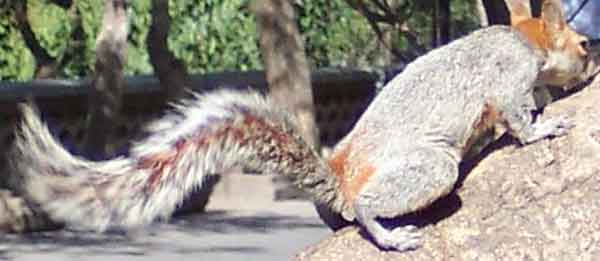
Sciurus aureogaster (*)
Superregnum: Eukaryota
Cladus: Unikonta
Cladus: Opisthokonta
Cladus: Holozoa
Regnum: Animalia
Subregnum: Eumetazoa
Cladus: Bilateria
Cladus: Nephrozoa
Superphylum: Deuterostomia
Phylum: Chordata
Subphylum: Vertebrata
Infraphylum: Gnathostomata
Megaclassis: Osteichthyes
Cladus: Sarcopterygii
Cladus: Rhipidistia
Cladus: Tetrapodomorpha
Cladus: Eotetrapodiformes
Cladus: Elpistostegalia
Superclassis: Tetrapoda
Cladus: Reptiliomorpha
Cladus: Amniota
Cladus: Synapsida
Cladus: Eupelycosauria
Cladus: Sphenacodontia
Cladus: Sphenacodontoidea
Cladus: Therapsida
Cladus: Theriodontia
Subordo: Cynodontia
Infraordo: Eucynodontia
Cladus: Probainognathia
Cladus: Prozostrodontia
Cladus: Mammaliaformes
Classis: Mammalia
Subclassis: Trechnotheria
Infraclassis: Zatheria
Supercohors: Theria
Cohors: Eutheria
Infraclassis: Placentalia
Cladus: Boreoeutheria
Superordo: Euarchontoglires
Ordo: Rodentia
Subordo: Sciuromorpha
Familia: Sciuridae
Subfamilia: Sciurinae
Tribus: Sciurini
Genus: Sciurus
Species: Sciurus aureogaster
Subspecies: S. a. aureogaster – S. a. nigriscens
Name
Sciurus aureogaster F. Cuvier, 1825
References
Sciurus aureogaster in Mammal Species of the World.
Wilson, Don E. & Reeder, DeeAnn M. (Editors) 2005. Mammal Species of the World – A Taxonomic and Geographic Reference. Third edition. ISBN 0-8018-8221-4.
IUCN: Sciurus aureogaster F. Cuvier, 1825 (Least Concern)
Vernacular names
cpa: Guai³
Deutsch: Rotbauchhörnchen
English: Mexican Gray Squirrel
français: Écureuil gris du Mexique
polski: Wiewiórka rudobrzucha
The Mexican gray squirrel (or red-bellied squirrel) (Sciurus aureogaster) is a tree squirrel in the genus Sciurus native to Guatemala and eastern and southern Mexico. It has been introduced to the Florida Keys.[3][1]
The alternate name should not be confused with the Indonesian red-bellied squirrel (Rubrisciurus rubriventer) or the Asian red-bellied tree squirrel (Callosciurus erythraeus).
Behaviour
Since the introduction of the species to Florida in the late 1930s, its nesting locations have become more irregular, nesting in varying species of trees and even choosing to nest in hurricane debris.[4]
Subspecies
The two subspecies each have many synonyms associated with them:[2]
The subspecies S. a. aureogaster was also known as S. a. chrysogaster, S. a. ferruginiventris, S. a. hypopyrrhus, S. a. hypoxanthus, S. a. leucogaster, S. a. maurus, S. a. morio, S. a. mustelinus, S. a. raviventer and S. a. rufiventris.
The subspecies S. a. nigrescens was also known as S. a. affinis, S. a. albipes, S. a. cervicalis, S. a. chiapensis, S. a. cocos, S. a. colimensis, S. a. effugius, S. a. frumentor, S. a. griseoflavus, S. a. hernandezi, S. a. hirtus, S. a. leucops, S. a. littoralis, S. a. nelsoni, S. a. nemoralis, S. a. perigrinator, S. a. poliopus, S. a. quercinus, S. a. rufipes, S. a. senex, S. a. socialis, S. a. tepicanus, S. a. varius and S. a. wagneri.
References
Koprowski, J.; Roth, L.; Reid, F.; Woodman, N.; Timm, R.; Emmons, L. (2017). "Sciurus aureogaster". IUCN Red List of Threatened Species. 2017: e.T20006A22248035. doi:10.2305/IUCN.UK.2017-2.RLTS.T20006A22248035.en. Retrieved 12 November 2021.
Thorington, R.W. Jr.; Hoffmann, R.S. (2005). "Sciurus (Sciurus) aureogaster". In Wilson, D.E.; Reeder, D.M (eds.). Mammal Species of the World: a taxonomic and geographic reference (3rd ed.). The Johns Hopkins University Press. pp. 754–818. ISBN 0-8018-8221-4. OCLC 26158608.
Long, J. L. (2003). Introduced Mammals of the World: Their History, Distribution and Influence. Csiro Publishing, Collingwood, Australia. ISBN 9780643099166
Ramos-Lara, Nicolás, and Fernando A. Cervantes. “ECOLOGY OF THE MEXICAN RED-BELLIED SQUIRREL (SCIURUS AUREOGASTER) IN MICHOACÁN, MEXICO.” The Southwestern Naturalist, vol. 56, no. 3, 2011, pp. 400–403. JSTOR, www.jstor.org/stable/23028144. Geoffrey H. Palmer, John L. Koprowski, Anthony J. Pernas, Nest tree and site selection of an introduced population of red-bellied squirrels (Sciurus aureogaster), Journal of Mammalogy, Volume 94, Issue 6, 16 December 2013, Page
Retrieved from "http://en.wikipedia.org/"
All text is available under the terms of the GNU Free Documentation License

